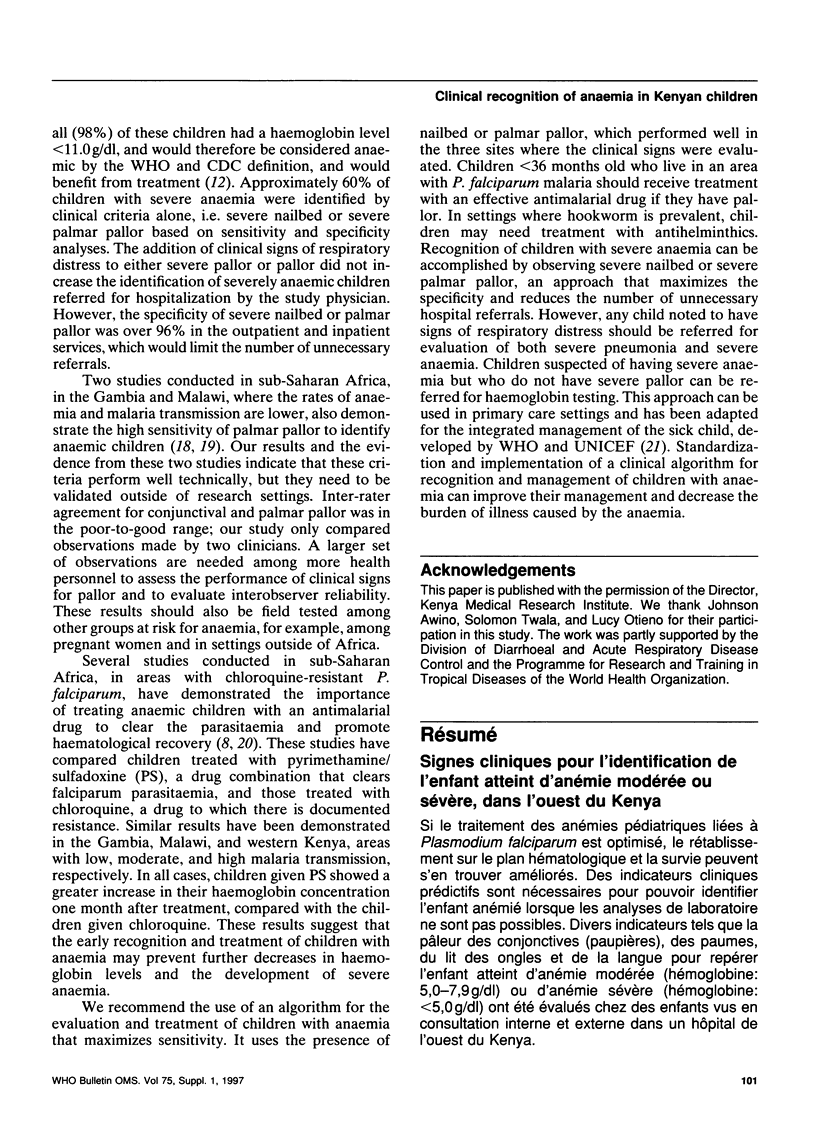Abstract
Optimal treatment of Plasmodium falciparum-related paediatric anaemia can result in improved haematological recovery and survival. Clinical predictors are needed to identify children with anaemia in settings where laboratory measurements are not available. The use of conjunctival (eyelid), palmar, nailbed, and tongue pallor to detect children with moderate anaemia (haemoglobin, 5.0-7.9 g/dl) or severe anaemia (haemoglobin, < 5.0 g/dl) was evaluated among children seen at an outpatient and inpatient setting in a hospital in western Kenya. Severe nailbed or severe palmar pallor had the highest sensitivity (62% and 60%, resp.), compared with severe conjunctival pallor (sensitivity = 31%), to detect children with severe anaemia in the outpatient setting. Children with moderate anaemia were best identified by the presence of nailbed or palmar pallor (sensitivity = 90% for both signs), compared with conjunctival pallor (sensitivity = 81%). Clinical signs of respiratory distress, in addition to the presence of severe pallor, did not increase the recognition of children requiring hospitalization for severe anaemia. Among inpatients, the sensitivity of severe nailbed pallor (59%) was highest for detecting children with severe anaemia, although the sensitivity of severe conjunctival pallor and severe palmar pallor was the same (53% for both signs). Presence of conjunctival pallor (sensitivity = 74%) was similar in sensitivity to both nailbed and palmar pallor (70% for both signs) among children with moderate anaemia. The sensitivity of tongue pallor was low among all children evaluated. Low haemoglobin levels were significantly associated with the likelihood of being smear-positive for P. falciparum. This study demonstrates that clinical criteria can be used to identify children with moderate and severe anaemia, thus enabling implementation of treatment algorithms. Children aged < 36 months who live in an area with P. falciparum malaria should receive treatment with an effective antimalarial drug if they have pallor.
Full text
PDF





Selected References
These references are in PubMed. This may not be the complete list of references from this article.
- Bloland P. B., Lackritz E. M., Kazembe P. N., Were J. B., Steketee R., Campbell C. C. Beyond chloroquine: implications of drug resistance for evaluating malaria therapy efficacy and treatment policy in Africa. J Infect Dis. 1993 Apr;167(4):932–937. doi: 10.1093/infdis/167.4.932. [DOI] [PubMed] [Google Scholar]
- Campbell C. C. Challenges facing antimalarial therapy in Africa. J Infect Dis. 1991 Jun;163(6):1207–1211. doi: 10.1093/infdis/163.6.1207. [DOI] [PubMed] [Google Scholar]
- Centers for Disease Control (CDC) CDC criteria for anemia in children and childbearing-aged women. MMWR Morb Mortal Wkly Rep. 1989 Jun 9;38(22):400–404. [PubMed] [Google Scholar]
- Greenberg A. E., Ntumbanzondo M., Ntula N., Mawa L., Howell J., Davachi F. Hospital-based surveillance of malaria-related paediatric morbidity and mortality in Kinshasa, Zaire. Bull World Health Organ. 1989;67(2):189–196. [PMC free article] [PubMed] [Google Scholar]
- Greenwood B. M. Asymptomatic malaria infections--do they matter? Parasitol Today. 1987 Jul;3(7):206–214. doi: 10.1016/0169-4758(87)90061-5. [DOI] [PubMed] [Google Scholar]
- Hedberg K., Shaffer N., Davachi F., Hightower A., Lyamba B., Paluku K. M., Nguyen-Dinh P., Breman J. G. Plasmodium falciparum-associated anemia in children at a large urban hospital in Zaire. Am J Trop Med Hyg. 1993 Mar;48(3):365–371. doi: 10.4269/ajtmh.1993.48.365. [DOI] [PubMed] [Google Scholar]
- Lackritz E. M., Campbell C. C., Ruebush T. K., 2nd, Hightower A. W., Wakube W., Steketee R. W., Were J. B. Effect of blood transfusion on survival among children in a Kenyan hospital. Lancet. 1992 Aug 29;340(8818):524–528. doi: 10.1016/0140-6736(92)91719-o. [DOI] [PubMed] [Google Scholar]
- Lozoff B., Jimenez E., Wolf A. W. Long-term developmental outcome of infants with iron deficiency. N Engl J Med. 1991 Sep 5;325(10):687–694. doi: 10.1056/NEJM199109053251004. [DOI] [PubMed] [Google Scholar]
- Marsh K., Forster D., Waruiru C., Mwangi I., Winstanley M., Marsh V., Newton C., Winstanley P., Warn P., Peshu N. Indicators of life-threatening malaria in African children. N Engl J Med. 1995 May 25;332(21):1399–1404. doi: 10.1056/NEJM199505253322102. [DOI] [PubMed] [Google Scholar]
- Perkins B. A., Zucker J. R., Otieno J., Jafari H. S., Paxton L., Redd S. C., Nahlen B. L., Schwartz B., Oloo A. J., Olango C. Evaluation of an algorithm for integrated management of childhood illness in an area of Kenya with high malaria transmission. Bull World Health Organ. 1997;75 (Suppl 1):33–42. [PMC free article] [PubMed] [Google Scholar]
- Schapira A., Beales P. F., Halloran M. E. Malaria: living with drug resistance. Parasitol Today. 1993 May;9(5):168–174. doi: 10.1016/0169-4758(93)90140-b. [DOI] [PubMed] [Google Scholar]
- Weatherall D. J., Abdalla S. The anaemia of Plasmodium falciparum malaria. Br Med Bull. 1982 May;38(2):147–151. doi: 10.1093/oxfordjournals.bmb.a071751. [DOI] [PubMed] [Google Scholar]
- Weber M. W., Mulholland E. K., Jaffar S., Troedsson H., Gove S., Greenwood B. M. Evaluation of an algorithm for the integrated management of childhood illness in an area with seasonal malaria in the Gambia. Bull World Health Organ. 1997;75 (Suppl 1):25–32. [PMC free article] [PubMed] [Google Scholar]
- Woodruff A. W., Ansdell V. E., Pettitt L. E. Cause of anaemia in malaria. Lancet. 1979 May 19;1(8125):1055–1057. doi: 10.1016/s0140-6736(79)92952-0. [DOI] [PubMed] [Google Scholar]
- Zucker J. R., Lackritz E. M., Ruebush T. K., 2nd, Hightower A. W., Adungosi J. E., Were J. B., Metchock B., Patrick E., Campbell C. C. Childhood mortality during and after hospitalization in western Kenya: effect of malaria treatment regimens. Am J Trop Med Hyg. 1996 Dec;55(6):655–660. doi: 10.4269/ajtmh.1996.55.655. [DOI] [PubMed] [Google Scholar]


